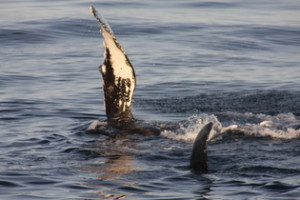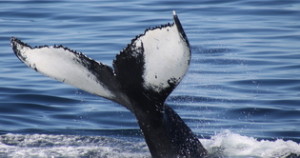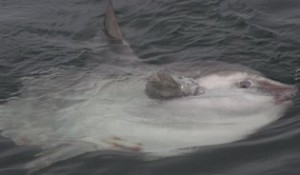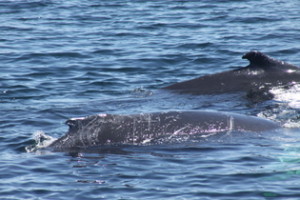Dolphin Fleet Naturalist Notebook 29 August to 4 September
29 August– Hurricane Daniel. All trips cancelled.
30 August– Hurricane Daniel. High seas- all trips cancelled.
31 August– After two days on shore it is finally time to board the Dolphin VIII and venture out into the Atlantic. While the skies are bright and sunny and the wind minimal, there is a remaining swell from Daniel. While substantial, the swell is less than expected, so we head east to see if the whales still are feeding off the eastern edge of Stellwagen Bank (or to our crew ‘the Triangle’). Just south of the Triangle we sight three groups of humpback whales on the move. These individuals have been in the area for the past several weeks, forming groups of between 3 to 6 whales varying in composition. In the first group we photographed Hancock, Whisk, Cajun and Lupine. While the first 3 are mature females, Lupine is a small whale of unknown gender first sighted in 2007 and named in 2008. The next group we watched, Percussion, Canopy and Draco were surfacing for a few breaths and then fluking high for a deep dive. Division, Venom and Bolide and her calf, also were moving about the area. The calf, now between 5 and 9 months old ventured further away from the group, not unusual for this time of the year when they seem to become a bit more independent. In the afternoon we returned to the Triangle and saw the same humpback whales plus Citation and Eruption. The behavior was similar to that of the morning trip but this time Bolide’s calf was over 1/8 of a mile away from its mother. Also in the area was a Minke whale, the smallest of the baleen whales in our waters.
1 September– A bright clear day with light winds from the Northeast. In the morning we sailed east to Peaked Hill where we sighted 3 species of baleen whales: Minkes, finbacks and humpbacks. There, we identified 5 humpback whales that had not recently been sighted in the Triangle. In fact, we photographed Rattan for the first time this season- close by was her first calf. Also in the area were Banyon, Elephant and a small juvenile first photographed this year. Each spring seems to bring an abundance of small humpback whales that remain unnamed until the following year. Most of the humpbacks were moving east, but Elephant was resting- a behavior we call logging. And in fact, resting whales look like large logs floating on the waters’ surface. Humpback whales do not sleep as we know it. They are air-breathing mammals who spend most of their lives underwater- every breath is a conscious decision. In contrast, we are involuntary breathers and can breathe while we are unconscious. By afternoon the finback and humpback whales have moved northeast and are in the Triangle. Like the day before there is a lot of movement about the area, fluking dives and few breaths on the surface. In the midst of this activity, Banyon and the small humpback we watched in the morning are logging. Other humpbacks sighted include Belly, Draco, Ravine, Percussion, Hancock, Lupine, Cajun, Milkweed, Division, Venom and Bolide and her calf. By evening, more whales have moved into the area, including 3 or more Minke whales. A few of the humpbacks are feeding just beneath the surface and several are feeding through bubble nets. Venom, who was flippering, was the most active. Joining the whales from the afternoon were Anvil and her calf, Ampersand, Firefly, Meerkat, Zap, Condensation, Softserve and Citiation. We sailed back into a brilliant sunset.
Venom flippering
2 September– Wednesday was sunny with light winds as we left the harbor. Our first sighting was a Minke whale, just off Race Point, the northernmost point of land in Provincetown. We ventured to the Triangle once again and sighted several humpback whales. Most of the humpbacks appeared to be feeding deep beneath the surface. They would take a few breaths moving continuously and lift their flukes high in the air. After several minutes they would surface energetically with resounding exhales. Whisk however began to lobtail, continually slapping her flukes on the surface.
Whisk lobtailing
Many of the humpbacks are the same as the days before, including: Draco, Percussion, Hancock, Lupine, Cajun, Bolide and her calf, Whisk, Canopy, Eruption and Citation. On our way back to Provincetown we sighted a large, triangular fin waves lazily to and fro. The boat is taken out of gear and we drift by one of natures most unlikely and bizarre creatures: the Mola mola or ocean sunfish. The word Mola is derived from Latin- meaning millstone, a fitting descriptor. The body is large, round and flattened with no discernable tail. The mouth, perpetually open, sucks in small animals such as jelly fish that drift by. Lying on its side, the ocean sunfish appears as a swimming head and can weigh as much as 2.5 tons. Despite size and shape, it swims gracefully through the water by synchronous flapping of its two large fins. It is possible that sunfish live to be over 100 years old.
Mola mola
Afternoon and evening we return to the Triangle. The humpbacks are energetically moving around the area as are Minke’s and finback whales. Bolide’s calf once again is a distance from its mother and the feeding whales. The whales we sighted in the morning were joined by Ventisca, Belly and a few juveniles in the afternoon. In the mix was a grey seal. Seals primarily eat fish and invertebrates; the most common prey for Cape Cod seals include squid, herring, mackerel and sand lance. Grey seals can be seen near shore off the back side of Cape Cod or near our ocean beaches all seasons, especially in summer. We returned to port amidst a blazing sunset.
3 September– Calm seas with a slight swell and a spattering of clouds. We are triangle bound! Most of our sightings on Thursday were of humpback whales with a few fleeting views of Mike’s and finbacks off the Race Point Station. Race Point was named for its powerful crosscurrent, known as a ‘race’. It is here that the flow of the Atlantic meets the countercurrent of Cape Cod Bay, treacherous bars lurk beneath the water’s surface and hundreds of ships met their fate. The HMS Somerset, the most notable shipwreck near Race Point, is immortalized in Henry Wadsworth Longfellow’s poem, “Paul Revere’s Ride.” While treacherous for early mariners, the powerful current at Race Point makes it an ideal area for fisherman, seabirds and whales, as the mixing of the ocean layers – called upwelling- make it nutrient rich and abundant with marine life.
A fin whale off Race Point
In the Triangle we see the same humpback whales as the day before plus a humpback named Infinity. Belly was flippering and a small whale was resting, but the remaining humpbacks seemed to be deep feeding and on the move. Few birds in the area are a sign that there are few sand lance, common prey for sea birds and whales, to be had at the surface. This is no surprise as sand lance burrow into loose sand, hence their common, descriptive name. In the sand at the bottom of Stellwagen Bank, they burrow to escape predation, to rest and to hibernate after spawning.
4 September– Friday is sunny with light winds and calm seas. Our sightings are closer to Provincetown today. Several humpback whales and a few Minke’s and finback whales off the southern edge of Stellwagen Bank in the Gerry Studds Stellwagen Bank National Marine Sanctuary. An ocean treasure, the sanctuary was designated by Congress in 1992 and is one of only 13 sites deemed to be of such special national significance. In these productive waters, a myriad of marine life lives, from the single-celled plankton to the great whales. Among its most well known species are humpback and right whales, northern lobsters, Atlantic cod and bluefin tuna.
Approximately the size of the state of Rhode Island, the sanctuary includes the submerged lands of Stellwagen Bank, all of Tillie’s Bank and Basin, and the southern portions of Jeffrey’s Ledge. It rises up from depths of 600 feet (183 meters), leveling off at an average depth of 100 feet (30.5 meters) below the water’s surface. It is the dynamics between the physical and biological that vitalizes and maintains the Stellwagen system. Cold water constantly flows south from the Gulf of Maine distributing nutrients, plants and animals. Nutrients are also brought to the Bank by local currents that move east to west, driven by the tides. Underwater currents and tide form areas of upwelling as they are deflected off the walls of the Bank, bringing nutrient rich water to the surface. Microscopic plants multiply rapidly in the sunlit, nutrient rich waters, small animals rise from the depths to eat the plants, fish eat the tiny animals and in turn are eaten by other fish, seabirds and whales. While most of the humpback whales appear to be sub-surface feeding, two pairs are resting on the surface: Follicle and her calf and Salt, the Grand Dame of Stellwagen and her oftentimes companion Cardhu. Salt, a grandmother, has been photographed every year since 1976 and has returned with 11 calves. Other humpbacks in the area include Draco, Canopy, Citation, Percussion, Eruption, Hancock, Cajun, Ventisca, Division, Bolide and calf, Perseid, Circuit, and Rattan and calf. We return to Provincetown after a successful day of whalewatching.
Follicle and her calf










